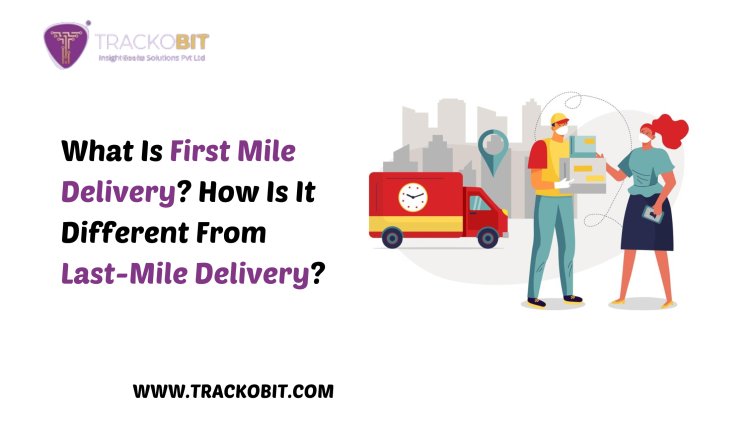What Is First Mile Delivery? How Is It Different From Last-Mile Delivery?
Get to know everything about first-mile delivery and last-mile delivery, and have a look at the top differences between the two terms.
Share this Post to earn Money ( Upto ₹100 per 1000 Views )

In the present world, efficiency is the key in all sectors, and the same is the case with the business sector. We all love to shop online, don't we? Well, of course, we do as it makes shopping easier for us. However, the same thing has made the job difficult for businesses as they need to focus on last-mile delivery as well.
Have you ever wondered how your favorite e-commerce websites reach you on time? Do you know how they make sure that your parcels make their way to your doorstep? Well, they do it by managing deliveries with the help of last-mile delivery software. However, along with this, they need to pay attention to first-mile delivery as well.
It won't be wrong to say that first-mile and last-mile delivery are two important stages of the entire delivery process. Their aim is to optimize their logistics and enhance customer satisfaction. Some people get confused between the two terms, and that's why we'll tell you about the differences between the two.
What Do You Mean By First-Mile Delivery?
First of all, let us guide you through the meaning of first-mile delivery. In simple words, it marks the initial step in the logistics process. It involves moving goods from the manufacturer to a central warehouse or distribution center. The first mile is all about getting products off the ground and into the logistics network.
A smooth first mile sets the stage for the entire supply chain. Yes, you heard it right! Any problem here can impact the delivery process, leading to delays and increased costs down the line. Efficiency in this process ensures that products are available on time and in good condition for the subsequent delivery stages.
First-mile delivery can include several activities including:
-
Picking and packing goods at the manufacturing site.
-
Transporting these goods to a warehouse or distribution center.
-
Ensuring proper documentation and compliance with regulations.
Understanding Last-Mile Delivery: What Is Last-Mile Delivery Software?
Now that you have understood first-mile delivery, let's move to last-mile delivery, the final step in the supply chain. It's the goods’ journey from a distribution center to the customers’ address. This stage is all about getting products into the hands of customers on time.
However, remember that last-mile delivery isn't just about transportation. It involves effective logistics and planning as well. This is why companies nowadays prefer incorporating last-mile delivery software like TrackoMile. Due to this, the international last-mile market will reportedly reach $84.72 billion by 2030.
Last-mile delivery software can:
-
Automate the route planning process to reduce delivery times.
-
Track deliveries in real-time to provide accurate ETAs to customers.
-
Manage delivery fleets and personnel to ensure effective performance.
-
Handle customer communications to keep them updated about their deliveries.
In today's competitive market, efficient last-mile delivery can be a game-changer. If you manage deliveries well, it can help you get loyal and satisfied customers.
Top 5 Differences Between First-Mile Delivery And Last-Mile Delivery
We hope that now you have understood the meanings of first-mile and last-mile delivery. Now, let us help you understand the difference between the two processes. Here are some pointers that'll explain how the two are different from each other:
-
Point of Origin vs. Point of Destination
First-mile delivery starts at the origin of the supply chain, usually at the manufacturer's location. It's about getting products into the logistics network. Last-mile deliveries, on the other hand, are all about reaching the final destination- the customers.
-
Scope and Scale
First-mile delivery often deals with bulk shipments and large quantities of goods moving to a central point. Remember that this stage involves fewer stops and more straightforward logistics. However, last-mile delivery is more complex as it involves multiple stops, smaller shipments, and diverse destinations.
-
Technology and Automation
Both of the stages benefit from technological advancements. However, the last mile relies more on specialized software. These software help in route optimization, real-time tracking, and customer communication. First-mile delivery focuses more on inventory management systems and bulk transportation logistics.
-
Customer Interaction
First-mile delivery typically doesn't involve direct customer interaction. It's a B2B operation between manufacturers and warehouses. Last-mile delivery, on the other hand, is a B2C process. Here, the delivery experience directly impacts customer satisfaction. For example, delivery delays in this process can result in unhappy customers.
-
Cost Implications
Last-mile delivery is often the most expensive part of the supply chain. It involves complex logistics, numerous stops, and high labor costs. First-mile delivery generally incurs lower costs due to bulk transportation and fewer handling points. This is why it's generally less than last-mile delivery costs.
Final Words
All in all, we can say that first-mile delivery and last-mile delivery are both important parts of the delivery process. However, both of them are different from each other. Each stage plays a unique role and comes with its own set of challenges and requirements. When you optimize both first-mile and last-mile processes, you can ensure smoother operations. Moreover, it reduces costs and helps you deliver a better experience to your customers.














